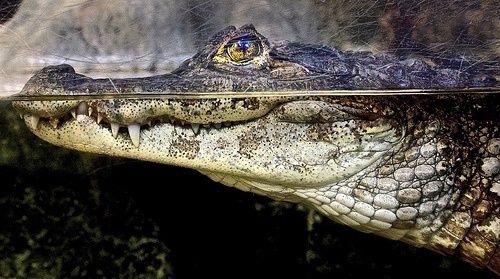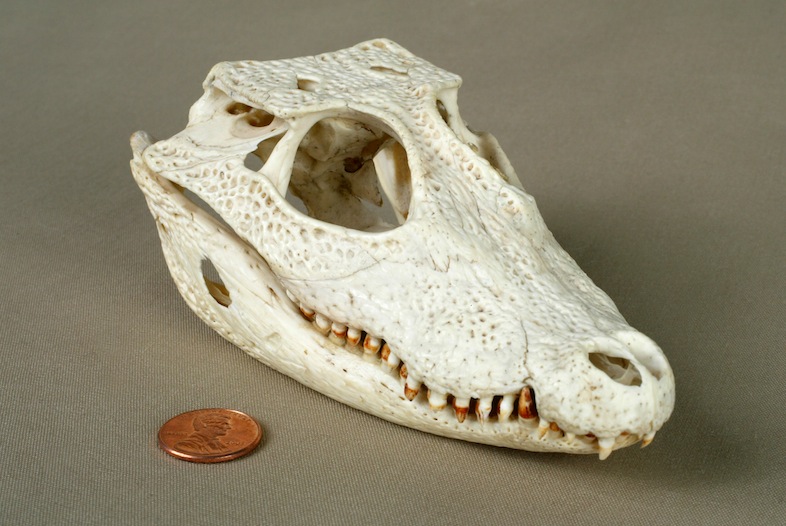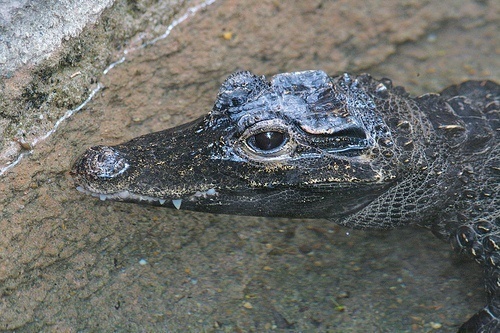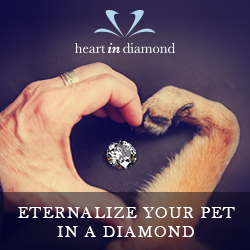D is for Dwarf Crocodile Facts
The dwarf crocodile (Osteolaemus tetraspis), also known as the African dwarf, broad-snouted or bony crocodile is an African crocodile, found in streams and lakes in Western Africa. It is the smallest extant crocodile species in the world. They can grow up to five feet long. This animal has the distinguishing feature of a “short” snout as compared to other members of the crocodile family. Read on for more interesting dwarf crocodile facts.
Dwarf Crocodile Facts: Characteristics
Did you know dwarf crocodiles reach an adult length of 4.9 feet (1.5 meters)? A record length for this species was 6.2 feet (1.9 meters). Adults typically weigh between 40 and 71 pounds (18 and 32 kg). Large females can weigh up to 88 pounds (40 kg) and large males can reach 180 pounds (80 kg).
Adults are black on their backs and sides with a yellowish underside with black patches. Juveniles have a lighter brown banding on body and tails and yellow patterns on the head.
The dwarf crocodile’s small size leads to heightened vulnerability to predators. However, this species of crocodile has a heavily armored neck, back and tail and also has osteoderms on its belly and underside of neck.
Dwarf crocodiles have a lifespan of 40 - 75 years. Share on X
The dwarf crocodile has a vertically flattened, muscular tail that is used to propel their bodies when swimming. with webbing between their toes which helps them to negotiate the slippery banks.
Their eyes and nostrils are located on the top of their heads to enable the them to both see and breathe while the rest of its body is submerged, allowing it to watch for prey and predators while being almost completely hidden.
The dwarf crocodile has a blunt short snout, as long as it is wide. It has 4 premaxillary teeth, 12 to 13 on the maxilla and 14 to 15 on the dentary bone. These cone shaped are razor-sharp teeth. Dwarf crocodiles continuously regrow and replace their old teeth which are pushed out by the new ones that develop below.
Dwarf Crocodile Facts: Habitat
You can find dwarf crocodiles across tropical lowland regions of sub-Saharan West Africa and West Central Africa.
Dwarf Crocodile Facts: Biology and behavior
The dwarf crocodile is a slow, timid, and mainly nocturnal reptile. It is a predator of vertebrates, large invertebrates such as crustaceans and will eat carrion when given the opportunity. It forages for its food in or near the water, but it may extend its search to land if there is extensive ground cover, or following heavy rains.
Their diet is generally seasonal, feeding on fish during the wet season’s floods. When faced with the scarceness of food during the dry season, individuals turn to crustaceans and food intake is generally reduced.
True to its solitary, nocturnal nature, a dwarf crocodile digs out a burrow to hide in and rest during the day, which can sometimes have a submerged entrance. They may also been seen nestling between tree roots that hang over the ponds in which it lives.
Dwarf Crocodile Facts: Reproduction
Female dwarf crocodiles build their nest mounds at the beginning of the wet season, between May and June. The nest is a mound of wet, decaying vegetation that acts as an incubator for the eggs due to the heat generated by the decomposition of the plant material. A small number of eggs are laid, numbering about 10, though it can be as many as up to 20 eggs.
Dwarf Crocodile Facts: Video of Babies Hatching in Captivity
You should watch this video published by Earth Unplugged!
Maddie plays dwarf crocodile mid-wife! Lucky her!
Wasn’t that fun? Lucky Maddie! Ahh, I love stuff like that!
Dwarf Crocodile Facts: Motherhood
The females fiercely guard their eggs from predators during the incubation period and after they hatch, roughly 85 to 105 days later. When the young are ready to hatch, they call out to her. She then digs them out of the mound to help them hatch. The mothers are even known to gently roll eggs that haven’t yet hatched around in their mouths to crack the shell. The mother then gently picks her young up in her mouth and carries them down to the water for safety. Dwarf crocodiles babies are usually independent of their mother very quickly, although they may stay close to her for at least a few weeks longer since the young are vulnerable to a great range of predators (birds, fish, mammals and reptiles, even including other crocodiles).
Dwarf crocodiles have a lifespan of 40 – 75 years. They are sexually mature at 4 or 5 years of age.
Dwarf Crocodile Facts: Conservation
Dwarf crocodiles are listed as Vulnerable by the International Union for the Conservation of Nature and Natural Resources (IUCN). There is an estimated 25,000 – 100,000 individuals thought to be left in the wild. However, they are a little-known species so conservationists don’t exactly know how their populations are faring under the growing human pressure over the ecosystems where they abide. Survey data shows a degree of decline, either by hunting for bush meat or habitat loss due to deforestation. However, it is a widely spread species, and presumably numerous, so is not as endangered as other forest denizens.
Though some skins are used in local manufacturing of leather products, they are of poor quality, so there is little interest in captive breeding or a sustainable use program.
Sources for Dwarf Crocodile Facts: Wikipedia and Arkive,org
Video Source: Earth Unplugged
D is for Dwarf Crocodile Facts: A-Z Collection of Animals #reptiles, #wildlife Share on X
***
*
I hope you have enjoyed, “D is for Dwarf Crocodile Facts“
You might also enjoy, “Mata Mata Turtle Facts, Unique, One of a Kind Turtle“
*
As always, thank you for taking the time to visit my blog!
*
A QUESTION FOR YOU: What animals or subjects would you enjoy learning more about?
*
*** Leave a comment below and remember to share. ***
It’s just sexy!
*

♥ PEACE ♥
- Mindful Travel With Your Dog This Holiday Season - December 23, 2019
- A-Z of Australia’s Endangered Wildlife - December 20, 2019
- Teaching Your Kids How to Walk the Dog Safely - December 2, 2019






Wow! These are really interesting animals. I never would have known they existed, had I not read this post. Thank you!
Thank you for stopping by, Sassenach! I always appreciate your visits. I’m glad you enjoyed the post! Take care! 🙂
Great Post. Very interesting read.
Thank you! I’m glad you found the post interesting. I love to share. I’ll head on over to your site now to see what you have to say about “entertainment.” Peace!
Some very interesting facts. I didn’t know much about them, though I have seen them in zoos in the past. They do look very cute.
I think they’re cool. Thanks for taking to the time to have a look at my post, Cait. I appreciate you! Come back soon! Heading over to read your post about Purchasing a Panda now. 🙂
They are adorable. That’s not a word I thought I would use to describe a crocodile, but they are so cute. I’m enjoying learning about different animals through your posts!
Thanks, Lisa. I love that you’re enjoying learning about different animals. It fun for me too! Take care, and come back soon! 🙂
A to Z. Amazing. I can honestly say that I never expected to read a blog about animals – your passion shines through the words. Great post.
Stuart
http://www.stuartlennon.com
Yes, animals are definitely my passion, Stuart. Thank you for taking the time to check out my blog. I truly appreciate that. Are you having fun with the A-Z Challenge. I’ll go on over to your site now and read what you have to say about “D is for Death.” Great topic. See you there! 🙂
I really enjoyed this article – I’d never even heard of this kind of crocodile -and they are – dare I say it? CUTE! Thanks for all the great info and the vid too! 🙂
They are really cute, I think, Anne. I’m glad you enjoyed learning about another new animals. Thanks for your visit and comment. I do appreciate you. 🙂